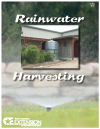 In many communities throughout Texas, 30 to 50 percent (or more) of the total water is used for landscape irrigation. With droughts putting a strain on public water supplies in 2011 and 2012, rainwater harvesting offers an alternative water source that benefits everyone.
In many communities throughout Texas, 30 to 50 percent (or more) of the total water is used for landscape irrigation. With droughts putting a strain on public water supplies in 2011 and 2012, rainwater harvesting offers an alternative water source that benefits everyone.
Landscape irrigation is the most common use of rainwater harvested in Texas. It is one of the easiest ways to use stored rainwater because it can be used without pumps and without intense treatment.
Rainwater is good for plants because it is free of salts and other minerals that harm root growth. As rainwater percolates into the soil, it forces salts down and away from root zones, allowing roots to grow better and making plants more drought tolerant. Use the calculator (link at the bottom of the page) to help determine cumulative storage and supplemental water use for your rainwater harvesting system.
When using rainwater for landscape irrigation, it is critical to be as efficient as possible. This includes applying only the amount of water that the plants need. This also means using drip irrigation. For more information on plant water needs, see the rainwater harvesting publication at the bottom of this page. For more information on drip irrigation, see this video (coming soon).
Related Resources
 EarthKind: Environmental Stewardship Programs for the Urban Landscape
EarthKind: Environmental Stewardship Programs for the Urban Landscape
Homeowners and landowners can construct systems to capture, store and use rainwater to water their landscape plants.
AgriLife Rainwater Harvesting Calculator

Pingback: Comment récupérer l’eau de pluie pour les plantes ? – Blogue de la ferme